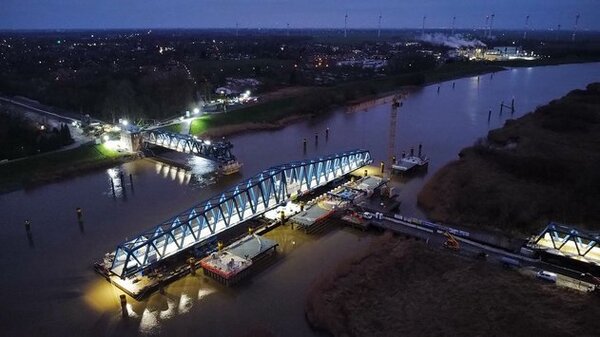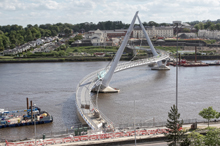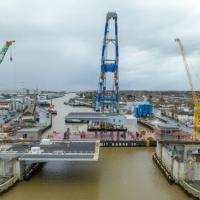The last section of Friesenbrücke, Europe’s largest rotating rail bridge was recently floated into place, bringing to a key milestone the Wunderline project, which will improve rail links between Germany and the Netherlands.

Barges prepare to place the 1,800t section of Friesenbrücke. Credit: DB InfraGO / Phil Leon Pickert
Friesenbrücke crosses the River Ems at Papenberg and Weener near the border between the two countries. It is a moveable bridge that will rotate to allow the passage of sea-going vessels. The new bridge replaces a bascule span that was hit by a ship in 2015. As well as providing a crossing for trains, it provides passage for cyclists and pedestrians. It will be completed and commissioned in the spring. Work on Friesenbrücke has been ongoing since summer 2021 (link opens in new tab).
sbp had responsibility for the 1,800t moveable bridge section. It was assembled and balanced in Papenberg and then stored on two pontoons. Engineers dammed the river with a barrage to achieve a constant water level. They then used steel cable winches and self-propelled modular vehicles to move the 145m rotating part into position before lowering it on to the substructure by ballasting the pontoons.
Operators will be able to rotate the moveable section 90 degrees in minutes. The movement is controlled from the listed bridge keeper’s house, which has been adapted and modernised.
The Friesenbrücke consortium includes Adam Hörnig, MCE and Depenbrock. MKP collaborated with DR. SCHIPPKE+Partner on the design of Friesenbrücke.
The Wunderline Route upgrade is a project by DB InfraGO and the national railway company of Germany Deutsche Bahn to improve infrastructure between the German city of Bremen with Groningen in the Netherlands.





